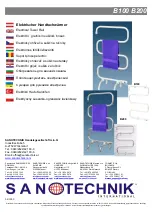
5
Notice
Discolouration of wall surfaces
Most heating appliances generate warm air convection
currents and transfer heat to any wall surface against
which they are situated.
Some soft furnishings (such as blown vinyl wallpapers)
may not be suitable for use where they are subject to
temperatures above normal room levels and the
manufacturer's advice should be sought before using this
type of wall covering adjacent to any heating appliance.
The likelihood of wall staining from convected air currents
will be increased in environments where high levels of
tobacco smoke or other contaminants exist.
1.7 Important Information.
This product uses insulation board and gaskets
containing Refractory Ceramic Fibres (RCF), which are
man-made vitreous silicate fibres. Excessive exposure to
these materials may cause irritation to eyes, skin and -
respiratory tract. Consequently, it is important to take care
when handling these articles to ensure that the release of
dust is kept to a minimum. To ensure that the release of
fibres from these RCF articles is kept to a minimum,
during installation and servicing we recommend that you
use a HEPA filtered vacuum to remove any dust and soot
accumulated in and around the fire before and after
working on the fire. When replacing these articles we
recommend that the replaced items are not broken up, but
are sealed within a heavy duty polythene bag, clearly
labelled as RCF waste. RCF waste is classed as a stable,
non-reactive hazardous waste and may be disposed at a
landfill licenced to accept such waste. Protective clothing
is not required when handling these articles, but we
recommend the use of suitable gloves to prevent irritation.
We also recommend you follow the normal hygiene rules
of not smoking, eating or drinking in the work area and
always wash your hands before eating or drinking.
This appliance does not contain any component
manufactured from asbestos or asbestos related products.
Installer Guide
1.0 Introduction
© GDC Group Ltd. 2012
The installation must be in accordance with this guide.
For the user’s protection, in the United Kingdom it is the law that all gas
appliances are installed by competent persons in accordance with the
current edition of the Gas Safety (Installation and Use) Regulations.
Failure to install the appliance correctly could lead to prosecution. GAS
SAFE REGISTER and CORGI require their members to work to
recognised standards.
In the United Kingdom the installation must also be in accordance with:
All the relevant parts of local regulations.
The relevant parts of the current editions of the following British
Standards:-
BS 5440 Part 1-
Installation of flues
BS 5871 Part 1-
Installation - Gas fires
BS 6891-
Installation of low pressure gas pipework
of up to 35mm (R1 ¼) in domestic
premises (2nd family gas) - specification.
-
In England and Wales, the current edition of the Building Regulations
issued by the Department of the Environment and the Welsh Office.
-
In Scotland, the current edition of the Building Standards (Scotland)
Regulations issued by the Scottish Executive.
-
In Northern Ireland, the current edition of the Building regulations
(Northern Ireland) issued by the Department of the Environment for
Northern Ireland.
-
In the republic of Ireland the installation must be carried out by a
competent person and also conform to the relevant parts of:
a) The current edition of IS 813 “Domestic Gas Installations”
b) All relevant national and local rules in force.
Where no specific instructions are given, reference should be made to the
relevant British Standard Code of Practice.
1.3 Considerations for timber framed buildings.
Installation to a timber-framed building should be in accordance with the
relevant sections of The Institute of Gas Engineers publication IGE/UP/7
“Gas installations in timber frame buildings”.
Please note that advice should be sought before installing in a timber
frame building since the alterations required may nullify any NHBC cover
relating to the property. If in doubt, guidance should be requested from
your local authority planning or building department.
Under no circumstances is the fire to be recessed into timber frame
constructions
.
1.4 Ventilation requirements.
No special ventilation bricks or vents are required into the room containing
the appliance.
1.5 Fireguard requirements.
A fireguard complying with BS 8423 should be fitted for the protection of
young children, the elderly, the infirm and pet animals.
1.6 Room considerations.
It is advisable that combustible fabrics such as curtains are not fitted above
the fire. If, however, this is unavoidable, the extreme bottom edge of the
fabric must be at least 780mm above the base of the fire.
1.2 Regulations, Standards and Law.






































